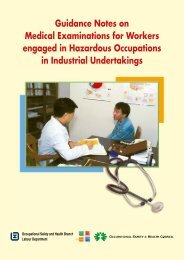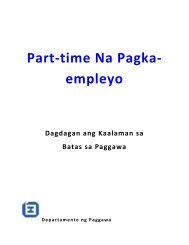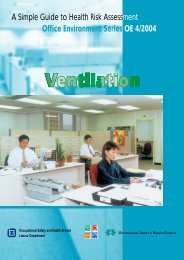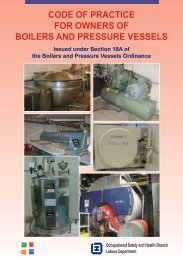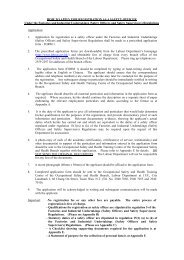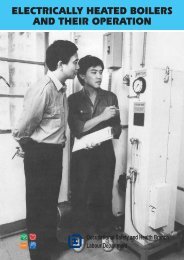An Analysis on Occupational Fatalities - Casebook Volume 1
An Analysis on Occupational Fatalities - Casebook Volume 1
An Analysis on Occupational Fatalities - Casebook Volume 1
You also want an ePaper? Increase the reach of your titles
YUMPU automatically turns print PDFs into web optimized ePapers that Google loves.
This publicati<strong>on</strong> is issued free of charge and can be obtained from offices of the<br />
Occupati<strong>on</strong>al Safety and Health Branch or downloaded from website of the<br />
Labour Department at http://www.labour.gov.hk/eng/public/os/B133.html.<br />
Addresses and teleph<strong>on</strong>e numbers of the offices can be found in website of<br />
the Department at http://www.labour.gov.hk.<br />
This publicati<strong>on</strong> may be freely reproduced except for advertising, endorsement<br />
or commercial purposes. Please acknowledge the source as “<str<strong>on</strong>g>An</str<strong>on</strong>g> <str<strong>on</strong>g>An</str<strong>on</strong>g>alysis <strong>on</strong><br />
Occupati<strong>on</strong>al <strong>Fatalities</strong> – <strong>Casebook</strong> <strong>Volume</strong> No. 1”.
<str<strong>on</strong>g>An</str<strong>on</strong>g> <str<strong>on</strong>g>An</str<strong>on</strong>g>alysis <strong>on</strong> Occupati<strong>on</strong>al<br />
<strong>Fatalities</strong> – <strong>Casebook</strong> <strong>Volume</strong> 1<br />
1
CONTENTS<br />
Foreword ...............................................................................................<br />
Case 1 A worker fell from an inclined gangway secured <strong>on</strong>to the end of a<br />
lorry parked <strong>on</strong> a public road....................................................<br />
Case 2 A worker fell from a landing platform down the hoistway to the<br />
ground....................................................................................<br />
Case 3 <str<strong>on</strong>g>An</str<strong>on</strong>g> electrician was electrocuted when mistakenly cutting a live<br />
electric cable...........................................................................<br />
Case 4 A site sub-agent was struck by an object falling from height <strong>on</strong><br />
the c<strong>on</strong>structi<strong>on</strong> site of a building project after typho<strong>on</strong>................<br />
Case 5 A cleaning worker was crushed to death by a c<strong>on</strong>tainer while being<br />
lowered by a rubber-tyre gantrycrane.......................................<br />
Case 6 <str<strong>on</strong>g>An</str<strong>on</strong>g> engineer was electrocuted while repairing a telecommunicati<strong>on</strong><br />
system inside an effluent tunnel....................................................<br />
Case 7 <str<strong>on</strong>g>An</str<strong>on</strong>g> aircraft mechanic fell over the edge of an unfenced elevated<br />
platform to the ground when carrying out routine check to an<br />
aircraft....................................................................................<br />
Case 8 A worker was struck by a metal pipe swinging under pressure and<br />
hit against a tunnel wall...........................................................<br />
Case 9 A worker was electrocuted while working in a building under<br />
c<strong>on</strong>structi<strong>on</strong>.............................................................................<br />
Enquiry.....................................................................................................<br />
2<br />
Page<br />
Number<br />
3<br />
4<br />
8<br />
14<br />
20<br />
24<br />
30<br />
36<br />
40<br />
44<br />
48
F O R E W O R D<br />
Workplace accidents are not just causing sufferings to the victims and<br />
their families. They also incur costs arising from work stoppage, insurance<br />
claims, medical and rehabilitati<strong>on</strong> expenses.<br />
It is recognized that most workplace accidents are preventable. Very often,<br />
the scenarios and causes have comm<strong>on</strong> phenomena. Unless the causes of<br />
workplace accidents are properly understood, less<strong>on</strong>s will not be learned<br />
and suitable improvements will not be made to secure the future safety<br />
and health protecti<strong>on</strong> of those who may be affected by a work activity.<br />
The resp<strong>on</strong>sible pers<strong>on</strong>s of workplaces need to understand why events<br />
happened, and act to make sure that they do not happen again.<br />
This casebook gathers a collecti<strong>on</strong> of fatal accident at work cases edited<br />
in a way for experience sharing <strong>on</strong> accident preventi<strong>on</strong>. It aims at providing<br />
precious less<strong>on</strong>s to those who are exposed to work activities and the<br />
management pers<strong>on</strong>nel, as well as case studies for safety training<br />
institutes.<br />
Occupati<strong>on</strong>al Safety and Health Branch<br />
Labour Department<br />
August 2003<br />
3
Case 1: A worker fell from an inclined gangway<br />
secured <strong>on</strong>to the end of a lorry parked <strong>on</strong> a public<br />
road<br />
Scenario<br />
A c<strong>on</strong>tractor took up a renovati<strong>on</strong> project at a building unit. The deceased (D/P)<br />
was a worker of a sub-c<strong>on</strong>tractor who took up from the renovati<strong>on</strong> c<strong>on</strong>tractor the<br />
demoliti<strong>on</strong> and removal of tiles and c<strong>on</strong>crete debris. Prior to the accident, the D/P<br />
was resp<strong>on</strong>sible for carrying the c<strong>on</strong>structi<strong>on</strong> debris up a lorry parked <strong>on</strong> a public<br />
road. A wooden gangway inclined at an angle of about 24 o was secured to the<br />
lorry platform at <strong>on</strong>e end, with the other end resting <strong>on</strong> the road surface. The D/P<br />
carried the load manually and walked up to the lorry platform al<strong>on</strong>g this gangway.<br />
4
Prior to the accident, he grabbed a c<strong>on</strong>crete block with both hands. While he<br />
was walking <strong>on</strong> the gangway to the lorry platform, he slipped and fell to the<br />
road surface. During his fall, the c<strong>on</strong>crete block struck <strong>on</strong> his chest. He was<br />
sent to hospital for treatment and subsequently passed away.<br />
C a s e A n a l y s i s<br />
The plank serving as gangway was 30 mm thick, 2.72 m l<strong>on</strong>g and<br />
0.23 m wide. It had two metal hooks at <strong>on</strong>e end for securing to the<br />
loading platform. Seven small planks of width 0.23 m and crosssecti<strong>on</strong><br />
18 mm x 20 mm were nailed <strong>on</strong>to the surface of the gangway<br />
as cleats for pers<strong>on</strong>s walking <strong>on</strong> it to secure their foothold.<br />
The loading platform was about 1.1 m from the ground, thus making<br />
the plank to incline at an angle of about 24 o when resting between<br />
the loading platform and the road surface.<br />
The c<strong>on</strong>crete block that the D/P was carrying at the time of accident<br />
was of size 0.42m x 0.45m x 0.1m, weighing about 20 kg.<br />
A combinati<strong>on</strong> of the following factors could have c<strong>on</strong>tributed to the<br />
cause of this accident:<br />
(a) The gangway involved in the accident was <strong>on</strong>ly 0.23m wide. It<br />
might have caused difficulties to pers<strong>on</strong>s to keep balance while<br />
walking <strong>on</strong> it. It was not c<strong>on</strong>sidered to be a safe means of access.<br />
5
C a s e A n a l y s i s<br />
(b) The D/P was having both hands engaged in carrying the c<strong>on</strong>crete<br />
block at his fr<strong>on</strong>t, and the c<strong>on</strong>crete block might have obstructed<br />
his view and thus the judgment to the c<strong>on</strong>diti<strong>on</strong>s of the gangway.<br />
(c) The protruding hooks at the anchoring point to the loading<br />
platform might have caused the D/P to trip and fall.<br />
(d) Autopsy report indicated that the blood alcohol level of the D/P<br />
might have affected the body coordinati<strong>on</strong> of the D/P.<br />
Before the work was carried out by the D/P, the management had not<br />
carried out a risk assessment <strong>on</strong> the manual handling operati<strong>on</strong> to address<br />
the aforementi<strong>on</strong>ed hazards and the necessary safety measures.<br />
Less<strong>on</strong>s to Learn<br />
A safe system of work should be provided and maintained for transporting<br />
and handling of the load. The system should cover areas such as:<br />
(a) a preliminary risk assessment before carrying out manual handling operati<strong>on</strong>s,<br />
which should identify the risks associated with the procedure of the work and<br />
formulate safety measures to be taken;<br />
(b) suitable mechanical means for the lifting and transportati<strong>on</strong> of a load from<br />
<strong>on</strong>e level to another;<br />
(c) when manual lifting of a load could not be avoided, large heavy objects<br />
should be broken up into smaller pieces for easy handling.<br />
6
Case 2: A worker fell from a landing platform<br />
down the hoistway to the ground<br />
8
Scenario<br />
The deceased (D/P) was employed by a sub-c<strong>on</strong>tractor in a housing project.<br />
The building c<strong>on</strong>structi<strong>on</strong> work was near completi<strong>on</strong>. The sub-c<strong>on</strong>tractor<br />
undertook the kitchen cabinet and steel basin fitting work of the residential<br />
flats. On the day of the accident, D/P and other workers arrived at the site and<br />
transported cabinets and basins to upper floors with a material hoist. After<br />
lunch, D/P worked with a co-worker to transport the basins from the 3/F to<br />
upper floors by the material hoist. <str<strong>on</strong>g>An</str<strong>on</strong>g>other team was resp<strong>on</strong>sible for receiving<br />
the loads and distributing them to the flats between the 30/F and the 38/F. In<br />
the course of work, D/P’s co-worker left the 3/F, leaving the D/P to work al<strong>on</strong>e.<br />
In the hoist operati<strong>on</strong>s, the hoist operator at the G/F could see the D/P standing<br />
<strong>on</strong> a landing platform at the 3/F level at a height of 12 metres above the<br />
ground. Signals were given by the D/P to the hoist operator through an electric<br />
bell. Sometimes, the D/P would communicate with the operator by direct<br />
shouting. In an operati<strong>on</strong> right before the time of the accident, the hoist<br />
operator, after hearing a shouting instructi<strong>on</strong> from the D/P, raised the hoist<br />
platform from the G/F to the 3/F. The hoist operator was told by the D/P that<br />
adjustment to the stopping level of the hoist platform was not required.<br />
Therefore, he waited <strong>on</strong> the G/F for further signal. After waiting for some time,<br />
the hoist operator suddenly heard a loud noise coming from the hoistway. He<br />
immediately ran to the hoistway and found the D/P lying in a pool of blood at<br />
the bottom of the hoistway. He also noticed the hoist platform was still moving.<br />
So, he rushed to stop the hoist. D/P was sent to the hospital and he passed<br />
away later.<br />
9
C a s e A n a l y s i s<br />
C a s e A n a l y s i s<br />
The hoist<br />
The hoistway had a cross-secti<strong>on</strong> of 1.53m (W) x 1.64m (L). Inside the<br />
hoistway, there was a hoist platform of 1.32m (W) x 1.33m (L), which<br />
was c<strong>on</strong>trolled by a winch system. Operati<strong>on</strong> of the hoist could be<br />
c<strong>on</strong>trolled from the c<strong>on</strong>trol panel in the G/F c<strong>on</strong>trol room, or through a<br />
pendant c<strong>on</strong>trol linked to the c<strong>on</strong>trol panel.<br />
Landing Gate<br />
By design, the hoist platform could stop at any floor. At each landing<br />
place, the entrance to the hoistway was provided with a two-flap gate.<br />
A spring-loaded micro-switch was fitted in the middle of left flap while<br />
a horiz<strong>on</strong>tal metal push bar <strong>on</strong> the other. Before the hoist could be<br />
activated, the gate should be in closed positi<strong>on</strong> to enable the metal<br />
push bar to press down the spring butt<strong>on</strong> of the micro-switch.<br />
It was also observed that the spring-loaded micro-switch at the hoistway<br />
gate <strong>on</strong> the 3/F, where the D/P was working, was not protected against<br />
tampering. It could be jammed, fastened or simply pressed down<br />
manually to render the hoist in operative mode even when the gate<br />
was opened. A site safety pers<strong>on</strong>nel disclosed that the hoistway gate<br />
at 3/F was in the open positi<strong>on</strong> when he reached there right after the<br />
accident. However, he did not notice any tampering of the micro-switch.<br />
The signalling system<br />
On the site, there was a circuit system for the signalling system of hoist<br />
operati<strong>on</strong>s. The circuit system provided sockets at each landing place<br />
10
C a s e A n a l y s i s<br />
of the hoist <strong>on</strong> the upper floors. Several means of the devices could be<br />
employed in the signalling system. By plugging a c<strong>on</strong>trol cable of the<br />
signalling device into the sockets at designated floors, the workers could<br />
give signals to the hoist operator <strong>on</strong> the G/F through <strong>on</strong>e of the following<br />
means:<br />
(a) visual signal of light bulb;<br />
(b) audible signal from electric bell;<br />
(c) communicati<strong>on</strong> by inter-communicati<strong>on</strong> device.<br />
On the day of the accident, the workers <strong>on</strong> the upper floors used electric<br />
bell to give signal to the hoist operator. In additi<strong>on</strong>, they also used their<br />
own mobile ph<strong>on</strong>es.<br />
No <strong>on</strong>e had eye-witnessed the accident. Apparently, the circumstances<br />
suggested that the D/P had fallen from the upper level, possibly from<br />
the edge of the landing platform of the hoistway at the 3/F level, but<br />
how and why he fell from there could not be ascertained. Nevertheless,<br />
the following could have c<strong>on</strong>tributed to the accident:<br />
(a) The micro-switch fitted to the hoistway gate could be easily<br />
tampered for the purpose of activating the hoist operati<strong>on</strong>s even<br />
when the gate was opened. Thus, the intent to keep the hoistway<br />
gate closed before moving of the hoist platform was defeated.<br />
(b) As the hoist could be operated with the hoistway gate opened, a<br />
worker would face the hazards of falling down the hoistway or<br />
being struck by the moving hoist platform.<br />
11
Less<strong>on</strong>s to Learn<br />
(a) <str<strong>on</strong>g>An</str<strong>on</strong>g> effective interlocking device should be installed <strong>on</strong> each landing gate of<br />
the material hoist to prevent the hoist from being operated before the gates<br />
are closed. The device should be designed and c<strong>on</strong>structed to prevent<br />
any tampering to defeat its purpose.<br />
(b) A maintenance programme for all switches, c<strong>on</strong>trols and safety devices of<br />
the material hoist should be established and implemented.<br />
(c) During the work, there should be an appropriate inspecti<strong>on</strong> system<br />
c<strong>on</strong>ducted by a supervisor who is competent in material hoist operati<strong>on</strong>s<br />
to check for unsafe situati<strong>on</strong>s and to effect rectificati<strong>on</strong> immediately, and<br />
to stop work if appropriate.<br />
(d) Every worker engaged in material hoist operati<strong>on</strong>s should be fully instructed<br />
<strong>on</strong> the correct methods and procedures to perform the job, to use the<br />
interlocking gate at the access to a hoistway properly, and to adopt the<br />
signalling system appropriate to safe hoist operati<strong>on</strong>s.<br />
(e) Every worker engaged in material hoist operati<strong>on</strong>s should be given all<br />
necessary and sufficient informati<strong>on</strong> of the possible dangers, such as the<br />
hazards of falling into the hoistway, the trapping by the moving hoist<br />
parts, etc., and the associated precauti<strong>on</strong>ary measures.<br />
12
Case 3: <str<strong>on</strong>g>An</str<strong>on</strong>g> electrician was electrocuted when<br />
mistakenly cutting a live electric cable<br />
14
Scenario<br />
On the day of the accident, maintenance of an airfield ground lighting (AGL)<br />
system in the airport was carried out after mid-night. The work c<strong>on</strong>sisted of<br />
replacing high voltage cable plugs, and cable cutting was <strong>on</strong>e of the steps.<br />
The deceased (D/P) and four other electricians <strong>on</strong> night shift were assigned<br />
with the task, and they performed the work at three different locati<strong>on</strong>s.<br />
The D/P and a co-worker (appointed as competent pers<strong>on</strong>) worked as a team.<br />
After successfully replacing the plugs of two lighting heads, the D/P’s team<br />
intended to replace that of numbering AGL-4650. At this juncture, the co-worker<br />
left the D/P to drive their service van closer to the scene. Up<strong>on</strong> returning, the<br />
co-worker noticed the D/P lying <strong>on</strong> the ground near another set of AGL system<br />
numbering AGL-4651. The cable leading to AGL-4651 was found having been<br />
cut, and a burn mark was observed at the cut end. The D/P was then taken to<br />
the hospital where he was certified dead.<br />
C a s e A n a l y s i s<br />
The two different sets of AGL system at the accident scene were<br />
energized by two separate circuits. Each circuit was linked up by<br />
cables in underground ducting, with the lighting heads embedded in<br />
underground casings and sealed up by cover plates. The two circuits<br />
were running side by side in the same directi<strong>on</strong>, with the lighting<br />
heads installed alternately at spacing about 7m. The cable joining<br />
each lighting head was provided with identificati<strong>on</strong>.<br />
15
C a s e A n a l y s i s<br />
Electrical output between 1,000 volts to 2,000 volts was supplied<br />
through different sources to each circuit. A c<strong>on</strong>stant supply of current<br />
ranging from 3 amperes to 6.5 amperes throughout the circuit,<br />
depending <strong>on</strong> the level of light intensity required, was maintained<br />
by the c<strong>on</strong>stant current regulator in the system.<br />
Before the commencement of work, the AGL system within the scope<br />
of work was rendered electrically dead with power source switched<br />
off and padlocked, and a warning notice was posted up there as<br />
well. However, the other AGL system was still energized.<br />
Autopsy report <strong>on</strong> the D/P revealed that electric burn marks believed<br />
to have been caused by c<strong>on</strong>tact with electric current were found <strong>on</strong><br />
his hands and left leg. Apparently, the electrocuti<strong>on</strong> occurred while<br />
the D/P was cutting an energized cable mistakenly during the work.<br />
The investigati<strong>on</strong> disclosed the following that might have<br />
c<strong>on</strong>tributed to this mishap:<br />
(a) Details of the job were verbally given by the in-charge to the<br />
workmen with the aid of cable routing layout plan and job sheet.<br />
However, the informati<strong>on</strong> shown <strong>on</strong> the cable routing layout plan<br />
was c<strong>on</strong>fusing with the <strong>on</strong>e being cut in the accident AGL<br />
No.4651 shown c<strong>on</strong>necting to the circuit of the intended work.<br />
In fact, it was linked to another circuit which was live.<br />
16
C a s e A n a l y s i s<br />
(b) The job was carried out in the dark. Error might have occurred<br />
when checking the small identificati<strong>on</strong> markings <strong>on</strong> the cables<br />
against those <strong>on</strong> the job sheet/layout plan.<br />
(c) Although clamp-<strong>on</strong> ammeters had been provided <strong>on</strong> the site for<br />
the workers for testing, there was no instructi<strong>on</strong> requiring a worker<br />
to use them.<br />
(d) A worker was appointed as the competent pers<strong>on</strong> in the team,<br />
and the D/P should have carried out electrical work under his<br />
supervisi<strong>on</strong>. However, he left the D/P shortly before the accident<br />
happened.<br />
Less<strong>on</strong>s to Learn<br />
(a) As far as practicable, all circuits of AGLs in the vicinity of the replacement<br />
work area should be opened and de-energized.<br />
(b) Cable routing layout plan and job sheet for showing the AGLs to be worked<br />
<strong>on</strong> should be properly designed to provide clear and accurate informati<strong>on</strong><br />
so as to enable the job be carried out safely.<br />
(c) All AGLs circuits should be proved “dead” before working. The procedure<br />
for identifying the status of the circuit should be documented.<br />
(d) A specific and easy-to-follow permit-to-work procedure should be provided<br />
and maintained to ensure that the safe system is properly followed. It<br />
should give clear guidance and indicati<strong>on</strong> to the workers <strong>on</strong> which AGL is<br />
“dead” and properly isolated from live sources, and is safe to be worked<br />
<strong>on</strong>.<br />
17
(e) Pers<strong>on</strong>s engaged in AGL plug replacement work should be competent pers<strong>on</strong>s<br />
or work under appropriate supervisi<strong>on</strong>. No workers should be allowed to<br />
engage in the replacement work without the required competency or<br />
supervisi<strong>on</strong>.<br />
(f) A safe system of work should be established to ensure the safety of the<br />
AGL maintenance work. That system should include suitable steps to ensure<br />
that proper training, informati<strong>on</strong>, supervisi<strong>on</strong> and instructi<strong>on</strong> are provided<br />
to workers, and that safe working practice and procedure are developed<br />
and adopted by the workers.<br />
Cable routing layout plan<br />
18
Case 4: A site sub-agent was struck by an<br />
object falling from height <strong>on</strong> the c<strong>on</strong>structi<strong>on</strong> site<br />
of a building project after typho<strong>on</strong><br />
20
Scenario<br />
Before the day of the accident, typho<strong>on</strong> signal no. 8 was hoisted. C<strong>on</strong>structi<strong>on</strong><br />
activities <strong>on</strong> a building c<strong>on</strong>structi<strong>on</strong> site were suspended. After the typho<strong>on</strong>, a<br />
sub-agent (D/P) returned to the c<strong>on</strong>structi<strong>on</strong> site. Before the site activities<br />
were fully resumed <strong>on</strong> the site, the D/P and the foreman of the scaffolding<br />
sub-c<strong>on</strong>tractor carried out an inspecti<strong>on</strong> to the damage caused to temporary<br />
structures such as bamboo scaffold, fans and nets erected at the external wall<br />
of the building. They stayed <strong>on</strong> the open podium beside Block 5 and discussed<br />
the remedial work . In the course of their discussi<strong>on</strong>, a piece of c<strong>on</strong>crete slab<br />
fell from height and struck the D/P. The c<strong>on</strong>crete slab badly damaged his helmet<br />
and knocked it off his head. The D/P suffered head injury and fell to the ground<br />
with his head bleeding seriously. He passed away <strong>on</strong> the same day.<br />
C a s e A n a l y s i s<br />
The c<strong>on</strong>structi<strong>on</strong> of Block 5 had reached the 50/F level. Bamboo<br />
scaffold had been erected at the external wall of the building and<br />
covered by fans and double-layer safety nets. In additi<strong>on</strong> to the<br />
provisi<strong>on</strong> of double-layer safety nets, the hoistway and the refuse<br />
chute at the external wall were also covered with plastic sheets.<br />
Catch fans had been erected at the external walls of the 27/F, 38/F<br />
and 48/F of Block 5. However, the typho<strong>on</strong> had damaged some fans<br />
and nets. At the side facing the accident scene, voids and openings<br />
of width 0.3 m to 0.45 m were found <strong>on</strong> the nets from the 45/F down<br />
to the 27/F. Debris and lumps of mortar were found scattered <strong>on</strong> the<br />
21
C a s e A n a l y s i s<br />
nets and fans, c<strong>on</strong>siderable accumulati<strong>on</strong> of debris at the 48/F level<br />
and c<strong>on</strong>crete slabs at the 38/F level.<br />
After the accident, the D/P was found lying <strong>on</strong> the ground at a distance<br />
of about 7m from Block 5. Two pieces of c<strong>on</strong>crete slabs were seized<br />
by the police in the vicinity of the accident scene. Forensic examinati<strong>on</strong><br />
indicated that <strong>on</strong>e of the c<strong>on</strong>crete slabs of dimensi<strong>on</strong> 250 mm x<br />
150 mm x 50 mm had struck the D/P as plastic residue of the safety<br />
helmet worn by the D/P had been left <strong>on</strong> the surface of the c<strong>on</strong>crete<br />
slab. This c<strong>on</strong>crete slab also resembled those found <strong>on</strong> the catch fan<br />
at the 38/F.<br />
The investigati<strong>on</strong> carried out immediately after the accident also<br />
revealed that the weather was still windy with occasi<strong>on</strong>al str<strong>on</strong>g<br />
gusts <strong>on</strong> the site.<br />
Hence, the accident might have been caused when <strong>on</strong>e of the<br />
c<strong>on</strong>crete slabs <strong>on</strong> the catch fan at the 38/F level fell through the<br />
voids and openings of the safety nets and struck the D/P.<br />
22
Less<strong>on</strong>s to Learn<br />
(a) C<strong>on</strong>structi<strong>on</strong> waste and materials accumulated <strong>on</strong> the fans and nets should<br />
be removed from time to time.<br />
(b) Employees should avoid carrying out any work <strong>on</strong> the open ground of a<br />
c<strong>on</strong>structi<strong>on</strong> site shortly after the typho<strong>on</strong>. Work should <strong>on</strong>ly be resumed<br />
after assessing the effects of inclement weather <strong>on</strong> the site c<strong>on</strong>diti<strong>on</strong>s.<br />
23
C a s e A n a l y s i s<br />
Case 5: A cleaning worker was crushed to death<br />
by a c<strong>on</strong>tainer while being lowered by a rubbertyre<br />
gantry crane<br />
24
Scenario<br />
In a c<strong>on</strong>tainer terminal, a c<strong>on</strong>tractor employed four cleaning workers including<br />
the deceased (D/P) to clean the terminal yard. Each worker worked separately<br />
in the area designated by the c<strong>on</strong>tractor, collecting rubbish <strong>on</strong> the ground with<br />
the aid of broom and spade, and c<strong>on</strong>veying it <strong>on</strong> a trolley to a rubbish collecti<strong>on</strong><br />
area for disposal.<br />
Four hours later, <strong>on</strong>ly three of them returned to their rest room after the cleaning<br />
work. Therefore, a worker went to find the D/P. At the juncti<strong>on</strong> of two main<br />
streets in the c<strong>on</strong>tainer stacking area where 12-metre-l<strong>on</strong>g c<strong>on</strong>tainers were<br />
stacked, the worker found two legs exposed from the base of a 16-t<strong>on</strong>ne<br />
c<strong>on</strong>tainer placed <strong>on</strong> the ground. There were a broken plastic broom and a<br />
spade next to the legs while a trolley was several metres away. It was reported<br />
immediately to the management of the terminal. When the 16-t<strong>on</strong>ne c<strong>on</strong>tainer<br />
was lifted up, the D/P’s body was found. Her safety helmet, with a straw hat<br />
over, was also found underneath the c<strong>on</strong>tainer. The D/P was certified dead<br />
later.<br />
C a s e A n a l y s i s<br />
On the accident scene, stacks of c<strong>on</strong>tainers each of dimensi<strong>on</strong> 12 metres<br />
(L) x 2.6 metres (W) x 2.9 metres (H) were arranged in rows. Facing a<br />
secti<strong>on</strong> of the main street, there were spaces reserved for the storage<br />
of c<strong>on</strong>tainers in six stacks. Right before the accident, c<strong>on</strong>tainers in the<br />
1st Stack were of 3 high, in the 2nd Stack were of 5 high, in the 3rd<br />
and 4th Stacks were both of 4 high, but no c<strong>on</strong>tainer was <strong>on</strong> the ground<br />
reserved for the 5th or 6th Stack.<br />
25
C a s e A n a l y s i s<br />
Through operati<strong>on</strong> of the spreader of a rubber-tyre gantry crane, a<br />
c<strong>on</strong>tainer <strong>on</strong> a truck would be picked up, brought to a positi<strong>on</strong> right <strong>on</strong><br />
the designated stack, or to the ground reserved for it. The process<br />
would be reversed for transporting a c<strong>on</strong>tainer from stack to truck.<br />
The driver’s cabin of the rubber-tyre gantry crane involved in the accident<br />
was about 18 metres above the ground. The spreader together with<br />
its hoisting mechanism was installed in fr<strong>on</strong>t of the cabin. On the cabin<br />
floor, there was a wide window for the operator to watch the movement<br />
of the c<strong>on</strong>tainer below. When the cabin was stati<strong>on</strong>ed above the 4th<br />
Stack, the visible area <strong>on</strong> the ground of the 5th Row through the floor<br />
window was restricted if a c<strong>on</strong>tainer was under suspensi<strong>on</strong> of the<br />
spreader. While the c<strong>on</strong>tainer was being lowered down gradually, the<br />
visible area would be further reduced.<br />
Although a camera of a closed circuit televisi<strong>on</strong> (CCTV) system was<br />
installed at the fr<strong>on</strong>t of the cabin for the operator to m<strong>on</strong>itor the situati<strong>on</strong><br />
of c<strong>on</strong>tainer yard below, it could not give a detailed c<strong>on</strong>diti<strong>on</strong> of the<br />
ground. There were blind spots when the yard was viewed from the<br />
cabin.<br />
The cleaning workers normally would not enter the space between<br />
two c<strong>on</strong>tainers. They would enter the stacking area and did the work<br />
<strong>on</strong>ly when there was no c<strong>on</strong>tainer in the area or any c<strong>on</strong>tainer handling<br />
activity nearby. As a general rule, the terminal prohibited pers<strong>on</strong>s to<br />
enter the c<strong>on</strong>tainer stacking area or get near to a machine under<br />
operati<strong>on</strong>. This requirement was m<strong>on</strong>itored by a patrol team <strong>on</strong> vehicles<br />
and by CCTV cameras installed <strong>on</strong> high lamp-posts.<br />
26
C a s e A n a l y s i s<br />
Before entering the c<strong>on</strong>tainer stacking area, the D/P should probably<br />
have knowledge that a rubber-tyre gantry crane was operating nearby<br />
because it was a piece of heavy mechanical equipment that would<br />
emit noises. She still remained in the area probably because she<br />
wanted to do some work there and had not expected that a c<strong>on</strong>tainer<br />
was to be lowered <strong>on</strong>to her positi<strong>on</strong>.<br />
The operator of the rubber-tyre gantry crane held a valid certificate for<br />
operating the crane. He had 15 m<strong>on</strong>ths of working experience. There<br />
was no signaller to assist him in the transport of the c<strong>on</strong>tainer.<br />
N<strong>on</strong>etheless, he had the practice to actuate the horn <strong>on</strong>ce before<br />
lowering a c<strong>on</strong>tainer <strong>on</strong>to the ground. Right before the accident, the<br />
horn had lasted for about <strong>on</strong>e sec<strong>on</strong>d. It was believed that the D/P<br />
was not aware of such short warning signal.<br />
In short, the investigati<strong>on</strong> revealed that the mishap could have been<br />
attributed to the following factors:<br />
(a) The terminal management did not lay down specific safety procedures<br />
<strong>on</strong> the cleaning work for the c<strong>on</strong>tractor to follow.<br />
(b) The c<strong>on</strong>tractor had not given any guideline to the workers <strong>on</strong> what<br />
c<strong>on</strong>diti<strong>on</strong> they could enter the c<strong>on</strong>tainer stacking yard to do the<br />
cleaning work. There was <strong>on</strong>ly verbal instructi<strong>on</strong> given by the<br />
foreman of the sub-c<strong>on</strong>tractor to the workers that no cleaning work<br />
to the c<strong>on</strong>tainer stacking yard should be performed while c<strong>on</strong>tainer<br />
handling was in progress.<br />
(c) There was no coordinati<strong>on</strong> between the terminal management<br />
resp<strong>on</strong>sible for handling operati<strong>on</strong>s and the c<strong>on</strong>tractor undertaking<br />
the cleaning work.<br />
27
Less<strong>on</strong>s to Learn<br />
(a) The c<strong>on</strong>tractor should, so far as is reas<strong>on</strong>ably practicable, coordinate with<br />
the terminal management <strong>on</strong> the provisi<strong>on</strong> and maintenance of a safe<br />
system of work to ensure the safety and health of all cleaning workers in<br />
the c<strong>on</strong>tainer stacking yard.<br />
(b) Safety measures including, but not limited to, the following should be<br />
taken:<br />
• Appointment of a cleaning supervisor to oversee the overall cleaning<br />
operati<strong>on</strong>s;<br />
• Co-ordinati<strong>on</strong> between the cleaning supervisor and the terminal<br />
management <strong>on</strong> arrangement of the cleaning area and the work schedule;<br />
• Isolati<strong>on</strong> of the z<strong>on</strong>e for cleaning work from any c<strong>on</strong>tainer handling<br />
activities and crane operati<strong>on</strong>s;<br />
• Placing of appropriate signage and traffic c<strong>on</strong>es at the area where<br />
cleaning is in progress;<br />
• Effective communicati<strong>on</strong> am<strong>on</strong>gst the cleaning workers, the cleaning<br />
supervisor and the c<strong>on</strong>trol tower of the terminal; and<br />
• M<strong>on</strong>itoring system to ensure the proper implementati<strong>on</strong> of safety rules<br />
and procedures.<br />
(c) Training and informati<strong>on</strong> <strong>on</strong> associated hazards and safety measures should<br />
be provided to all cleaning workers.<br />
28
Case 6: <str<strong>on</strong>g>An</str<strong>on</strong>g> engineer was electrocuted while<br />
repairing a telecommunicati<strong>on</strong> system inside an<br />
effluent tunnel<br />
30
Scenario<br />
<str<strong>on</strong>g>An</str<strong>on</strong>g> effluent tunnel of length 7.5 km and diameter 2.7 m had two portal ends<br />
located at Diam<strong>on</strong>d Hill and Shatin respectively. A telecommunicati<strong>on</strong> system<br />
had been previously installed at the ceiling of the tunnel to enable workmen<br />
engaged in maintenance work inside the tunnel to communicate with those<br />
staying outside by radio. The system c<strong>on</strong>sisted of a l<strong>on</strong>g feeder cable and<br />
signal amplifiers at regular intervals to enhance power transmissi<strong>on</strong> of signals.<br />
During the maintenance, effluent was stopped from discharging into the tunnel<br />
to facilitate the work.<br />
On the day of the accident, the deceased (D/P) who was an engineer and a<br />
worker were resp<strong>on</strong>sible for fine-tuning and testing the telecommunicati<strong>on</strong><br />
system. By using a tunnel inspecti<strong>on</strong> vehicle, they reached a signal amplifier<br />
of the telecommunicati<strong>on</strong> system at 4.8 km from the Shatin Portal. The vehicle<br />
had rubber tyres and its chassis had a steel chain touching the ground. They<br />
went to the top of the vehicle to carry out the work.<br />
The D/P removed the signal amplifier from a plastic enclosure and lowered it<br />
<strong>on</strong>to a wooden table. He then opened the amplifier plastic cover and tuned<br />
the electric module card inside. Throughout the tuning process, the amplifier<br />
remained c<strong>on</strong>nected to the feeder cable. As the working area was dark, the<br />
co-worker held a torch to provide lighting to the D/P. While the D/P was kneeling<br />
<strong>on</strong> the top of the vehicle to carry out the job, he received an electrical shock<br />
and fell down. The co-worker immediately carried the D/P out of the tunnel.<br />
Unfortunately, he was certified dead up<strong>on</strong> arrival at hospital.<br />
31
C a s e A n a l y s i s<br />
The telecommunicati<strong>on</strong> system that the D/P was working had two<br />
direct current boosters, each c<strong>on</strong>nected to the feeder cable end at<br />
the portal of the tunnel. Through this feeder cable, the booster<br />
supplied direct current to the system at a voltage of 42V. The tunnel<br />
inspecti<strong>on</strong> vehicle was battery-driven at a voltage of 38V. There<br />
were no other electrical services, nor lighting, <strong>on</strong> the accident scene.<br />
By design, the earth of the system was arranged in the following<br />
manner:<br />
(a) At each portal end, the earth of the communicati<strong>on</strong> equipment<br />
and that of the boosters were c<strong>on</strong>nected to a comm<strong>on</strong> earth<br />
busbar, then to the earthing system.<br />
(b) The outer sheath of the feeder cable was made of copper wires<br />
and was always c<strong>on</strong>nected to the earth at the cable ends.<br />
(c) Inside the plastic casing of each signal amplifier, there was a<br />
layer of aluminium foil b<strong>on</strong>ded by earth cables to the electr<strong>on</strong>ic<br />
module card and the outer sheath of the feeder cable. The<br />
arrangement had provided a comm<strong>on</strong> earth screen to shield the<br />
electr<strong>on</strong>ic module card.<br />
There was a lightning protecti<strong>on</strong> system installed at the c<strong>on</strong>trol kiosk<br />
and the inlet chamber at the Shatin Portal. The system would direct<br />
high voltage current induced by lightning to protect the<br />
telecommunicati<strong>on</strong> equipment and the main power supply system.<br />
Autopsy report <strong>on</strong> the D/P disclosed that burn marks were found <strong>on</strong><br />
his left chest and left leg near the knee joint respectively. They were<br />
32
C a s e A n a l y s i s<br />
likely to be the path of electric current passing through the body.<br />
The record of the H<strong>on</strong>g K<strong>on</strong>g Observatory indicated that thunderstorm<br />
warning was issued before the accident. Thunderstorm and several<br />
str<strong>on</strong>g lightning were prevailing at Shatin Portal at the time of the<br />
accident. The envir<strong>on</strong>ment inside the tunnel was wet.<br />
Thus, the electrocuti<strong>on</strong> might have been caused in the following<br />
manner:<br />
(a) When the accident happened, the D/P was kneeling <strong>on</strong> the top<br />
of the tunnel inspecti<strong>on</strong> vehicle, which was electrically c<strong>on</strong>nected<br />
with the tunnel floor. At the same time, there was thunderstorm,<br />
with lightning, prevailing at the Shatin Portal. It might be possible<br />
that a lightning flash struck <strong>on</strong> the lightning protecti<strong>on</strong> system at<br />
Shatin Portal, or <strong>on</strong> the earth direct in its vicinity. The lightning<br />
strike would produce a large current flow in the earth in that<br />
general area and caused an instantaneous rise in the earth<br />
potential which could be in thousands of volts.<br />
(b) As the outer sheath of the feeder cable was always c<strong>on</strong>nected<br />
to the earth at the two cable ends, the potential of the cable’s<br />
copper sheath at Shatin Portal would therefore rise to a high<br />
voltage which would be transferred from the cable end at Shatin<br />
Portal, al<strong>on</strong>g the feeder cable into the effluent tunnel, towards<br />
the cable end at Diam<strong>on</strong>d Hill Portal. Thus, a high voltage surge<br />
was experienced by the signal amplifiers, including the <strong>on</strong>e<br />
involved in the accident.<br />
33
C a s e A n a l y s i s<br />
C a s e A n a l y s i s<br />
(c) As the accident scene was at a distance of 4.8 km from Shatin<br />
Portal, the tunnel floor and the surrounding would be at earth<br />
potential at or close to zero volt, and so was the vehicle <strong>on</strong><br />
which the D/P was staying owing to the indirect linking of the<br />
vehicle chassis to the tunnel floor.<br />
(d) On the other hand, the D/P had already removed the plastic<br />
cover of the signal amplifier, with the electr<strong>on</strong>ic module card<br />
exposed. He might have touched direct, or might have been<br />
very close to, the electr<strong>on</strong>ic module card at the particular moment.<br />
He would therefore experience a high voltage difference<br />
between his upper body/hands and his legs. A side flashing<br />
occurred and a leakage current thus flew from the amplifier,<br />
through the D/P’s body, the tunnel inspecti<strong>on</strong> vehicle, the tunnel<br />
floor, and finally entered the earth at local. As a result, the D/P<br />
received the electric shock.<br />
Less<strong>on</strong>s to Learn<br />
(a) A competent pers<strong>on</strong> should be appointed to carry out risk assessment of the<br />
working envir<strong>on</strong>ment inside the effluent tunnel before the commencement of<br />
the work. The risk assessment should identify the hazards likely to be present,<br />
recommend the safety measures to be taken, and state the work method,<br />
materials and plant to be used when the work is carried out.<br />
(b) No worker should enter or remain in the effluent tunnel unless the<br />
recommendati<strong>on</strong>s in the risk assessment report have been implemented and<br />
a permit for safe entry has been issued.<br />
34
C a s e A n a l y s i s<br />
(c) In adverse weather c<strong>on</strong>diti<strong>on</strong>, such as thunderstorm or lightning, working<br />
inside the tunnel <strong>on</strong> c<strong>on</strong>ductors or c<strong>on</strong>ductive parts of any communicati<strong>on</strong><br />
system, lightning protecti<strong>on</strong> system, or other electrical services should be<br />
strictly prohibited.<br />
(d) When carrying out work <strong>on</strong> any electrical system inside the effluent tunnel,<br />
all workers should stay <strong>on</strong> an equipotential z<strong>on</strong>e that is b<strong>on</strong>ded to an<br />
effective local earth. All equipment, plant and c<strong>on</strong>ductive parts at the<br />
working place should also be b<strong>on</strong>ded together electrically to an effective<br />
local earth to ensure that no hazardous potential difference exists between<br />
different parts of a worker’s body that would cause a leakage current flow.<br />
(e) The risk assessment report and the permit for safe entry into the effluent<br />
tunnel should be displayed at a c<strong>on</strong>spicuous place at its entrance.<br />
35
Case 7: <str<strong>on</strong>g>An</str<strong>on</strong>g> aircraft mechanic fell over the edge<br />
of an unfenced elevated platform to the ground<br />
when carrying out routine check to an aircraft<br />
Scenario<br />
The deceased (D/P) was a mechanic resp<strong>on</strong>sible for checking of an aircraft <strong>on</strong><br />
the day of the accident. Shortly before the accident, the D/P and two co-workers<br />
carried out visual inspecti<strong>on</strong> <strong>on</strong> the structural part of an aircraft. They had to<br />
open the batwing door at the pyl<strong>on</strong> to inspect the inner parts, and to fasten<br />
the door afterwards. Working at the end of an extensible ramp of an elevated<br />
platform, the D/P reached out bey<strong>on</strong>d the edge of the extended ramp to fasten<br />
the batwing door, but fell to the ground 3.5 m below. He was sent to hospital<br />
and passed away subsequently.<br />
36
C a s e A n a l y s i s<br />
The platform involved was a scissors type elevated platform mounted<br />
<strong>on</strong> a truck. It had an area of 2.43 m x 6.09 m. The built-in extensible<br />
ramp underneath the platform was 2.28m in width and could be<br />
extended bey<strong>on</strong>d the fr<strong>on</strong>t-end of the platform to enable workmen to<br />
reach different parts of the aircraft for maintenance work.<br />
At the edge of the extensible ramp, there were slots for inserting<br />
secti<strong>on</strong>s of removable guard-rail. This c<strong>on</strong>structi<strong>on</strong> facilitated the removal<br />
of guard-rails to cope with the c<strong>on</strong>tour of an aircraft when the raised<br />
platform was stati<strong>on</strong>ed under it. However, no guard-rail or fencing<br />
arrangement was provided at the lateral sides of the ramp. With the<br />
extensible ramp in extended positi<strong>on</strong>, the team c<strong>on</strong>sidered that some<br />
guard-rails, if installed, would cause obstructi<strong>on</strong> to the movement of<br />
the batwing door, and would crash the wing of the aircraft. Hence,<br />
guard-rails at the extensible ramp were not installed.<br />
Investigati<strong>on</strong> revealed that at the time of the accident:<br />
(a) Most of the guard-rails at the platform had not been installed.<br />
Guard-rails were provided <strong>on</strong>ly at the rear of the platform while<br />
the extensible ramp was totally unfenced.<br />
(b) The door latch was at a horiz<strong>on</strong>tal distance of 0.26m away from<br />
the left side of the ramp, and at a vertical distance of 1.5m above<br />
the ramp.<br />
(c) The D/P was not wearing any safety belt or harness at the time of<br />
the accident, nor was there any anchorage for the attachment of<br />
safety belt or harness. He was not protected from falling to the<br />
ground while reaching out to latch the door.<br />
37
C a s e A n a l y s i s<br />
The accident also reflected the inadequacies in the safety management<br />
system of the company:<br />
(a) No risk assessment was c<strong>on</strong>ducted to evaluate the possible hazards<br />
the workers might encounter and the safety measures to be adopted.<br />
(b) There was no method statement or safe working procedures for<br />
the operati<strong>on</strong>.<br />
(c) There was no instructi<strong>on</strong> <strong>on</strong> how the operative staff could reach<br />
the batwing door safely.<br />
(d) No safety harness, belt or fall protecti<strong>on</strong> arrangement was provided<br />
in the vicinity, or issued to staff for pers<strong>on</strong>al use. The employees<br />
were <strong>on</strong>ly told to get the safety harnesses from the store when<br />
needed.<br />
Apparently, there was no system of work in place, and the team was<br />
left to exercise their pers<strong>on</strong>al knowledge and experience to develop<br />
the appropriate safe method. Fall preventi<strong>on</strong> specific to carrying out<br />
such inspecti<strong>on</strong> work <strong>on</strong> the elevated platform, or <strong>on</strong> the extensible<br />
ramp, was not properly instituted. All these c<strong>on</strong>tributed to the occurrence<br />
of the accident.<br />
Less<strong>on</strong>s to Learn<br />
(a) A safe system of work should be developed and implemented to ensure<br />
the safety of workers carrying out inspecti<strong>on</strong>, maintenance and repair of<br />
aircraft at height. The system should include the following :<br />
38
• carrying out a risk assessment to identify the potential hazards<br />
associated with the inspecti<strong>on</strong> work;<br />
• providing the workers with detailed method statement and clear<br />
instructi<strong>on</strong>s <strong>on</strong> the working procedures, associated hazards and safety<br />
precauti<strong>on</strong>s to be adopted during work; and<br />
• providing the workers with sufficient safety training specific to the<br />
inspecti<strong>on</strong> work, including the safe operati<strong>on</strong> procedures and the<br />
precauti<strong>on</strong>ary measures.<br />
(b) Steps should be taken to prevent workers falling from height during work.<br />
Such steps should include the provisi<strong>on</strong>, use and maintenance of working<br />
platforms with suitable guard-rails or fencing. Where it is impracticable to<br />
provide guard-rails or fencing, suitable fall arresting system, such as safety<br />
net, safety harness and anchorage, should be provided.<br />
39
Case 8: A worker was struck by a metal pipe<br />
swinging under pressure and hit against a tunnel<br />
wall<br />
40
Scenario<br />
On the day of the accident, a sub-c<strong>on</strong>tractor assigned the deceased (D/P),<br />
who was a foreman, to lead a team of workers to carry out c<strong>on</strong>creting of arch<br />
lining inside a tunnel. C<strong>on</strong>crete was pumped to the arch lining through a metal<br />
pipeline. After the c<strong>on</strong>creting work, the workers carried out purging of the<br />
pipeline to clear the c<strong>on</strong>crete residue which would be used to form the slab of<br />
a sump pit. They disc<strong>on</strong>nected the end of the pipeline from the arch lining and<br />
inserted a foam-rubber ball into the pipeline. The pipeline was then c<strong>on</strong>nected<br />
to an air receiver. The discharge end of the pipeline, composed of bent pipes,<br />
was c<strong>on</strong>nected to the sump pit. Under the pressure of compressed air, the<br />
foam-rubber ball pushed the c<strong>on</strong>crete residue al<strong>on</strong>g the pipeline to discharge<br />
at the sump pit. When the pumping was almost complete, the pressure caused<br />
the bent secti<strong>on</strong> to swing fiercely. The D/P standing nearby was struck by a<br />
bent secti<strong>on</strong> and was thrown up a height of three metres. His head hit against<br />
the tunnel wall and sustained fatal injury.<br />
C a s e A n a l y s i s<br />
The tunnel had a diameter of 5 metres. The pipeline involved in the<br />
accident was over 100 metres in length and had diameters 150mm<br />
externally and 125mm internally. The additi<strong>on</strong>al secti<strong>on</strong>s of the<br />
pipeline to the pit c<strong>on</strong>sisted of two 7.5m external arc length bent<br />
secti<strong>on</strong>s and two straight secti<strong>on</strong>s of 3m and 1m respectively.<br />
However, these secti<strong>on</strong>s were not secured or anchored in positi<strong>on</strong><br />
by any means. With a compressed air pressure of about 0.8 MPa,<br />
the unsecured pipe end was caused to swing and led to the mishap.<br />
41
C a s e A n a l y s i s<br />
Purging of the pipeline with compressed air would pose great danger<br />
if improperly handled. The site management had not established<br />
any safe system of work to identify the hazards associated with the<br />
operati<strong>on</strong> and to adopt sufficient safety measures to eliminate the<br />
danger. The team members were not trained <strong>on</strong> the hazards in the<br />
job and the safety measures to be adopted, nor were they instructed<br />
<strong>on</strong> the proper steps and procedures and supervised to secure the<br />
pipeline before carrying out the purging work.<br />
Less<strong>on</strong>s to Learn<br />
A safe system of work should be developed and implemented to eliminate<br />
the hazards and to c<strong>on</strong>trol the risks arising from the c<strong>on</strong>crete c<strong>on</strong>veyance through<br />
pipeline and the associated pumping operati<strong>on</strong>s <strong>on</strong> the c<strong>on</strong>crete residue. The<br />
system of work should include the following elements:<br />
(a) Detailed risk assessment should be carried out to identify the potential<br />
hazards associated with the operati<strong>on</strong> of pumping c<strong>on</strong>crete through pipeline<br />
and clearing c<strong>on</strong>crete residue from pipeline with compressed air.<br />
(b) Design and c<strong>on</strong>structi<strong>on</strong> of the pipeline should be properly planned by<br />
engineer with suitable technical knowledge and experience. Relevant<br />
method statement, instructi<strong>on</strong> and plan should be provided in details<br />
to the workers for assembling the pipeline.<br />
(c) Adequate anchorage with suitable design, c<strong>on</strong>structi<strong>on</strong> and spacing should<br />
be provided and maintained to secure the pipeline in positi<strong>on</strong>, especially<br />
at the bends and ends both of which forming an integral part of the pipeline,<br />
42
to avoid danger arising from violent pipeline movement.<br />
(d) Method statement, informati<strong>on</strong> and instructi<strong>on</strong>s <strong>on</strong> the working procedures,<br />
associated hazards and safety precauti<strong>on</strong>s for c<strong>on</strong>crete pumping and<br />
purging operati<strong>on</strong> should be provided to workers.<br />
(e) Adequate training in c<strong>on</strong>creting work and the associated c<strong>on</strong>crete pipeline<br />
purging operati<strong>on</strong>, including the safe operati<strong>on</strong> procedures and the<br />
precauti<strong>on</strong>ary measures, should be provided to workers.<br />
43
Case 9: A worker was electrocuted while<br />
working in a building under c<strong>on</strong>structi<strong>on</strong><br />
Scenario<br />
The c<strong>on</strong>structi<strong>on</strong> site involved was a building site near completi<strong>on</strong> stage. The<br />
deceased pers<strong>on</strong> (D/P) was a ventilati<strong>on</strong> duct installati<strong>on</strong> worker employed<br />
by the sub-c<strong>on</strong>tractor resp<strong>on</strong>sible for the installati<strong>on</strong> of ventilati<strong>on</strong> ducts and<br />
fans. At the time of accident, such installati<strong>on</strong> work was undertaking at shop<br />
units <strong>on</strong> ground floor by the D/P and his employer.<br />
44
The ceiling of the shop units was 4.6 m high and the ventilati<strong>on</strong> duct was<br />
erected at a height of 3.8 m. A bamboo scaffold of 2.9 m high was erected <strong>on</strong><br />
the ground. Ventilati<strong>on</strong> duct installati<strong>on</strong> work had to be carried out <strong>on</strong> this<br />
bamboo scaffold. A wooden ladder of 3.05 m high was placed leaning against<br />
a wall by the side of the scaffold for access and egress. The sub-c<strong>on</strong>tractor<br />
was required to install the ventilati<strong>on</strong> ducting and to c<strong>on</strong>nect a cable from a<br />
fused spur mounted at the ceiling to a ventilati<strong>on</strong> fan in each shop unit. The<br />
lighting of the shop units was supplied with electricity from a source at 1/F.<br />
The fused spur was also supplied from the same source.<br />
After the installati<strong>on</strong> of the ventilati<strong>on</strong> ducting for the shop units, the employer<br />
had to c<strong>on</strong>nect the cable between the fused spur unit and the ventilati<strong>on</strong> fan.<br />
He claimed that he had checked with a tester that the fused spur unit was not<br />
energized but he was not so familiar with the testing. In fact, he had <strong>on</strong>ly<br />
checked <strong>on</strong>e of the terminals <strong>on</strong> the fused spur. Furthermore, he was not a<br />
Registered Electrical Worker under the Electricity Ordinance.<br />
When the employer c<strong>on</strong>nected the blue and the yellow/green wires of a 3wire<br />
cable to a fused spur unit, D/P was doing some packing work. Then, he<br />
saw D/P climbing up the wooden ladder from the ground. Shortly afterwards,<br />
he heard the D/P screamed and found him lying unc<strong>on</strong>scious <strong>on</strong> the ground<br />
with blood stains by the side. D/P was certified dead in the hospital.<br />
45
C a s e A n a l y s i s<br />
After the accident, it was found that the fused spur was energized,<br />
and the lights in the shop units were switched <strong>on</strong>. While the employer<br />
was c<strong>on</strong>necting <strong>on</strong>e end of the cable to the fused spur, the cable<br />
was hanging <strong>on</strong> a sprinkler pipe at the ceiling, with its free end 300<br />
mm above the bamboo scaffold, close to the wooden ladder.<br />
It was believed that the cable was energized at time of wire<br />
c<strong>on</strong>necti<strong>on</strong> and D/P might have touched the other end while climbing<br />
up the ladder. Burn marks were found <strong>on</strong> D/P’s right hand.<br />
The employer claimed that he had been told by the resident<br />
electrician that the electrical circuit would be de-energized in that<br />
afterno<strong>on</strong>. He had not got such c<strong>on</strong>firmati<strong>on</strong> before cable c<strong>on</strong>necti<strong>on</strong>.<br />
However, the resident electrician claimed that he had told the<br />
employer to approach him before work. There might have been<br />
misunderstanding over their c<strong>on</strong>versati<strong>on</strong>.<br />
Less<strong>on</strong>s to learn<br />
For the preventi<strong>on</strong> of electrical hazard in this situati<strong>on</strong>,<br />
(a) Work should be c<strong>on</strong>ducted by a Registered Electrical Worker or under<br />
immediate supervisi<strong>on</strong> of an authorized pers<strong>on</strong>.<br />
(b) Fused spur unit should be rendered dead before commencing cable c<strong>on</strong>necti<strong>on</strong>.<br />
(c) Clear communicati<strong>on</strong> should be maintained for work to be safely d<strong>on</strong>e.<br />
46
ENQUIRY<br />
If you wish to know more about occupati<strong>on</strong>al safety and health informati<strong>on</strong>,<br />
you may c<strong>on</strong>tact Occupati<strong>on</strong>al Safety and Health Branch of the Labour<br />
Department through –<br />
Hotline : 2559 2297<br />
E-mail : enquiry@labour.gov.hk<br />
Informati<strong>on</strong> <strong>on</strong> the services offered by Occupati<strong>on</strong>al Safety and Health Council<br />
can be obtained through hotline 2739 9000.<br />
48



